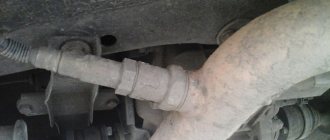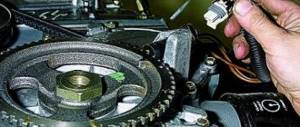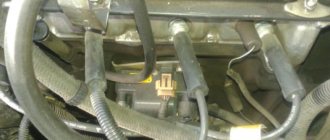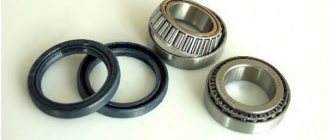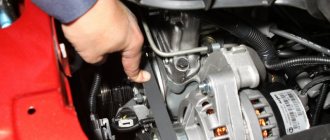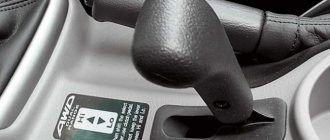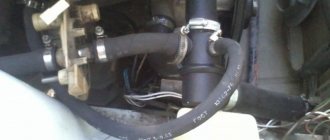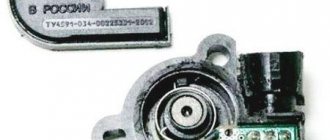Reasons why the cooling fan does not work on a Chevrolet Niva
To maintain the optimal temperature in the engine, a cooling system is installed in the car.
One of the main elements in this system are fans, thanks to which the required amount of air is supplied to the engine through the radiator core. If it stops working, the Niva Chevrolet cooling fan overheats as excess heat begins to accumulate. Unlike classic cars, it has two fans, making the functioning of the systems much more complicated. If the arrow that shows the temperature is in the red area, and the cooling system refuses to work, and at the same time the cooling fan does not turn on, then the car should be taken to a car service center as quickly as possible, or you should try to find the cause of the malfunction yourself.
Fans of the Niva Chevrolet cooling system are used for forced ventilation of the radiator. They increase the intensity of heat dissipation while driving at low speeds and are the only way to cool the antifreeze in a plug or “toffee”.
The electrical circuits of Niva Chevrolet cars produced before and after 2009 are different. In both cases, 50-amp fuses protecting the electric fan power circuits are located in an additional unit. It is located behind the glove box on the passenger side of the cabin. The figure shows where the fan fuses are located.
If the permissible current is exceeded, the insert melts and the circuit opens. Therefore, fuses are the first thing to check if the electric cooling fan does not work. The performance of a part can be assessed visually or using an ohmmeter (multimeter). To do this, you will first have to remove the fuse from the socket.
The additional block contains not only fuses. There are also three electromagnetic relays that control the operation of the electric motors of the cooling system. Their control circuits are powered from the ignition switch and on-board controller outputs, and the power current comes from the battery through fuses.
The relay operates as follows:
- Voltage is applied to the control terminals.
- Current passes through the inductor, resulting in an electromagnetic field.
- The steel contacts attract and close.
- The current passing through the relay drives the electric motor.
As soon as the control voltage disappears, the contacts open under the influence of the spring and the fan stops.
You can check the functionality of the relay in three ways:
- Replace the relay with a known working one and test the operation of the system.
- With the engine off and the ignition on, disconnect the temperature sensor connector. You should hear the relay click.
- Dismantle and test the output contacts with a multimeter, applying voltage to the terminals of the induction coil.
The control unit receives information about the antifreeze temperature from a temperature sensor. It is a resistor whose resistance changes with heating and cooling: from 1.3-1.8 kOhm at 30℃ to 155-196 Ohm at 90℃. You can check its performance using an ohmmeter and a thermometer. To do this, you need to remove the part, immerse it in water and measure the resistance at different temperatures.
The sensor is located on the engine head in the area of the exhaust pipe of the cooling system. You can unscrew it with a socket or socket wrench.
Everyone knows that modern cars have a water engine cooling system in their design, which allows many times to increase the service life of not only the engine, but also the entire mechanism as a whole. The Chevrolet Niva also has a radiator in its design that is filled with coolant.
This liquid circulates through the system, thereby cooling the car engine. But the engine temperature exceeds 100 degrees, so if this liquid is not cooled, it will soon turn from cooling to heating. This is precisely why there is a radiator cooling system, the operation of which is carried out by a fan.
But since the Chevrolet Niva is equipped with a powerful 1.7-liter engine, two fans are used to cool the radiator. In this article, we will look at how these devices work, or rather, what is the main element of turning on these devices on a Chevrolet Niva SUV.
The cooling fan is powered by a constant voltage of 12 V from the battery. They turn on when two sensors located in the engine reach a certain temperature. So, when the first sensor reaches a temperature of 99 degrees Celsius, it is triggered, which causes the first fan to turn on.
It has two rotation speed positions - high and low rotation speeds. When the second sensor reaches a value of 101 degrees, then, accordingly, the second device turns on. Thus, the cooling devices of the Chevrolet Niva engine are briefly activated. But we are interested in what role such a small device as a relay, of which there are three on the Chevrolet Niva, plays in this process.
The radiator cooling fan does not work (does not turn on) - reasons, troubleshooting
— blown, check the fuse that controls the fan
— the fan switch sensor (DVS) is faulty
- faulty fan relay
- faulty fuse box
- power cable break
— break in the output path to the radiator sensor wire
— the gasket under the head is burned out (coolant does not pass into the cylinder)
Problems with the cooling fan usually occur in used cars with decent mileage. This breakdown manifests itself in different ways; the fan may not work stably, may turn on late or not turn on at all.
There can be quite a few reasons why the fan does not turn on, from a banal fuse blown to more complex problems associated with a malfunction of the thermostat or problems with the electrical wiring of the vehicle's on-board network.
If the engine boils, but the fan still does not turn on, then the first thing that comes to mind for most motorists is problems with the fan wiring. However, very often the wiring has nothing to do with it, and the real reason lies precisely in the thermostat. The device designed to monitor the temperature of the coolant (coolant) may fail or simply jam, after which the coolant stops circulating through the radiator, as a result, the radiator sensor does not work, and the fan itself does not turn on.
Also interesting: Headlight diagram and lighting Niva 2121, Niva 2131
Then check the fuse that controls the fan; if the fuse is blown, replace it with a intact one. If the cause is not a fuse, you need to check the fan itself directly. The power wires come to it; often they simply crumble or break off due to age. Alternatively, the reason may lie in the plug, so if everything is fine with the wiring, turn off the power to the fan and check the plug for a malfunction. Connect power to the fan directly, for example, from the battery; if the fan does not react in any way, we conclude that the fan is faulty.
Check the fan switch sensor (FSW) located on the radiator. To do this, you need to disconnect the plugs and then connect them together; if the fan does not work, the DVV is faulty and requires replacement.
It is necessary to connect the wire going to the fuse box directly to ground (usually white with a black stripe). If after this the fan starts working, we can conclude that the second black wire has broken; try to find the break and check whether its connection to ground is reliable. After that, we connect the two wires together and see what happens, if the fan turns on, then the problem was a bad connection.
Check the fan relay, it is quite possible that the problem is there. In order to find out, simply replace it with an adjacent relay, then connect the radiator sensor wires to each other, see above. The fan will turn on - the problem is a faulty relay.
Next, you need to check the voltage to see if it is supplied to the fan through the fuse box. To do this, take a piece of wire and install it in the relay connectors; if the fan is working, the reason why the fan does not work is in the fuse box.
It is likely that voltage is not being supplied to the fan relay. To check this, you can use the “old-fashioned” method. We take a light bulb that will serve as a “control”. If there is no light bulb, just lightly strike the other end of the wire against ground, if you see a spark, there should be no problems, most likely this is not the reason. If you don’t see a spark, most likely there is no voltage in this connector, that is, there is a break in the track in the fuse block.
If, after checking all of the above, you find the reason why the radiator fan does not turn on, you only have to check one wire - the radiator sensor wire. To do this, you must remove the switch as it does not allow access to the fuse box plugs. This means we remove the plug from the fuse block and check the radiator sensor wire for a break.
We check as follows: connect the wire to the “ ” terminal of the battery, install the second end into the connector of the chip. Next, remove the plug from the sensor and connect the light bulb. If there is no light bulb, make a “teal” to ground. If there is no voltage, most likely this wire is broken.
If the fan does not turn on, the reason may be completely unexpected, for example, a burnt gasket under the head. Switching on does not occur for the reason that the coolant does not enter the cylinder, while gases from the cylinder penetrate into the coolant, creating an effect known as an air lock.
WHAT TO DO IF THE RADIATOR COOLING FAN DOES NOT WORK
Circuit breakers
The electrical circuits of Niva Chevrolet cars produced before and after 2009 are different. In both cases, 50-amp fuses protecting the electric fan power circuits are located in an additional unit. It is located behind the glove box on the passenger side of the cabin. The figure shows where the fan fuses are located.
Also interesting: Where is the Chevrolet Niva fuel pump relay located?
If the permissible current is exceeded, the insert melts and the circuit opens. Therefore, fuses are the first thing to check if the electric cooling fan does not work. The performance of a part can be assessed visually or using an ohmmeter (multimeter). To do this, you will first have to remove the fuse from the socket.
Fan relay
As a rule, we don't pay much attention to the heating or air conditioning of a Chevrolet Niva until they stop working. These systems keep you warm in winter and cool in summer. The ability to control heating and air conditioning is a guarantee of comfortable travel regardless of the time of year.
Despite the fact that at first glance these systems only affect the comfort of the driver and passengers during the trip, it turns out that they are closely connected with the defrosting system and remove steam from it. If the system malfunctions, driving the Niva in conditions of limited visibility will significantly increase the danger of movement.
The refrigeration system uses a compressor, condenser, evaporator and expansion valve. The refrigerant is compressed using a compressor, causing it to change from a liquid to a gaseous state, raising the temperature at the same time. The heated gas is cooled to a liquid state and passes to the expansion valve.
As the liquid passes through the expansion valve, it turns back into a gaseous state where it is cooled by the evaporator. The blower then blows the cooled air directly into the vehicle's interior through the vents. The Niva's air conditioning is also controlled using the control panel.
- System diagnostics from 500 rub.
- Pumping out old freon from 1,100 rubles.
- Radiator flushing from RUB 1,100.
- Leak detection from RUB 560.
- Disinfection and cleaning from RUB 1,100.
- Refrigerant injection from RUB 1,100.
Front bumper (removal/installation) — RUB 1,500 Front bumper (repair) — RUB 2,000 Front bumper (painting) — RUB 6,500 Front right fender (repair) — RUB 2,500 Front right fender (painting) — RUB 6,500. Right windshield pillar (painted) — RUB 3,500. Car wash — RUB 500.
The price is indicated on a turnkey basis (work and materials).
Front bumper (replacement) - 1,500 rubles. Front bumper (painting) - 6,500 rubles. Front right fender (replacement) - 1,000 rubles. Front right fender (painting) - 6,000 rubles. Right wing mounting bracket (repair) - RUB 2,000 Right wing mounting bracket (painting) — RUB 1,250 Front panel (repair) — RUB 2,000 Front panel (painting) — RUB 1,250 Front fog lights (installation) — RUB 1,500 Car wash m — 500 rub.
The designers of the Chevrolet Niva used a dual fan unit in the cooling system. This slightly complicated the connection diagram, but sharply increased the efficiency of radiator airflow. The fans are driven by 12-volt DC synchronous motors with a permanent magnet inductor. Electric motors have a closed, non-demountable design and do not require maintenance.
The power of each electric motor is 110 W. The fan assembly draws 18 amps.
And also interesting: ✅ Niva 2121 tire pressure -
The fans are turned on one by one using an electromagnetic relay controlled by the on-board computer. When the coolant heats up above 99 degrees, the electric fan located closer to the engine air intake starts. The switch-on temperature of the second impeller is 101 degrees. The fan connection diagram is shown below.
The fan power system includes three relays and a resistor, which, if necessary, provides a reduced rotation speed of the first motor. Power is supplied from the battery through fuses that save the wiring and battery in the event of a short circuit. Control signals come from pins 29 and 68 of the motor controller.
Consecutive switching on and off of engines reduces the load on the on-board electrical network. In most cases, it is possible to normalize the temperature only with the help of the first fan. This is especially useful when driving at night, when headlights and side lights put a lot of stress on the generator.
The ability to force fans on can be useful when driving off-road or in city traffic jams. However, the designers of the Chevrolet Niva did not provide the car with this function. It can be implemented independently or at a service station. It is necessary to connect backup relays parallel to the switching contacts and power them from a button installed in the car interior.
It is useful to equip the Chevrolet Niva with a switch that forcibly turns off the fan motors. This will protect their blades when fording water obstacles.
Problems with the electric motor. If the electric motor fails, its rotor will not spin, and accordingly, the impeller will not rotate. You can check the performance of the electric motor by connecting it directly to the battery. To do this, you will need to take two wires, connect them to two battery terminals and two electric motor terminals.
If the fan does not spin when connected directly to the battery, we can conclude that the electric motor needs to be replaced; Problems with the sensor. If the sensor is unable to detect the coolant temperature and transmit a signal to turn on the electric motor, it will need to be replaced. To make sure that it is not working, you need to disconnect two wires from it and short them together.
If the electric motor starts to spin the impeller, this will indicate that the sensor is faulty and needs to be replaced; There is no tension. The third and most common reason for a non-working radiator cooling fan is the lack of voltage in its power supply circuit. If there is a break in the wires or a fuse fails, the circuit will be de-energized.
RADIATOR COOLING FAN IS NOT WORKING: HOW TO USE THE CAR
Try turning on forced operation of the fan from the battery; If the fan is not forced, you should drive at a constant speed of about 60 kilometers per hour or higher so that the oncoming air flow cools the fluid on the radiator without the help of a fan. It is also recommended to turn on the heating system in the car interior so that some of the heat from the coolant escapes into the cabin.
Technical parameters of Chevrolet Niva (2123) 1.7 / Chevrolet Niva (2123) in a 5-door body. SUV with an 80 hp engine, 5 manual transmission, produced from 2002 to 2009.
Forced shutdown of engine cooling system fans in Chevrolet Niva (VAZ 2123)
To avoid getting the radiator broken by the fan blades when crossing a ford, and to save the blades themselves, I forced the fans to turn off. The implementation is in the pictures below.
0:343
1:848
standard diagram for turning on the fans in the shnivy 2006.
1:946
2:1451
circuit for forced shutdown of fans with shutdown alarm
2:1593
Implemented on a five-pin relay and a standard button for the fog light. In the non-pressed position, current flows freely through the five-pin relay according to the standard fan switching circuit. When you press the button, the control circuit for turning on the fans opens, and the current begins to power the alarm lamp and the bell. The button is used respectively to control a five-pin relay.
2:2292
3:504
a button for fog lights was purchased, in which the signaling LED was replaced from green to red and the cover with an image of a fan
3:781
4:1286
a 12V howler was purchased, which emits an intermittent loud signal when voltage is applied
4:1459
The howler is not indicated in the diagram, but it is connected in parallel with the alarm lamp (LED).
4:1632
5:2137
Implementation, wiring the relay connection with a blue wire
5:99
6:604
what it looks like when assembled. the relay is screwed to the left under the additional relay
6:732
Here 1 is an additional relay, 2 is a relay for turning on the left fan, 3 is a relay for turning on the right fan, 4 is a relay for forcing the fans to turn off. ATTENTION! In cars of different years of production, the location of the relay may change and differ from the diagram above. Look for a diagram directly for the car of your year of manufacture. If the diagrams match the one above, then you can check the location and determine the required relays using the purple-blue wire - in the diagram above, there is only one such wire and connects only the required relays for turning on the left and right fans.
6:1819
7:2324
button with fan image and backlight
7:90
8:595
button with a picture of a fan and an alarm
8:692
The circuit has been tested in operation - you press it - the red alarm LED lights up, the howler, as expected, beeps at intervals to blow the brain away and the fans turn off, press it - the alarm goes off and the fans turn on.
8:1125
https://www.drive2.ru/l/288230376153135045/
8:1172 next article:
Installing a radio in a Chevrolet Niva (VAZ 2123)
Having built the expeditionary trunk, it was time to organize radio communications in the shnivy on its basis. In my version
9:1998
Rating 0.00 [0 Vote(s)]
14365
Possible malfunctions and their causes
Niva heating consists of many elements. The key elements are: heater, wiring, control valve, fan and control panel. The heater resembles a small radiator. It is located next to the dashboard and has an inlet and outlet through which the coolant flows. The valve is responsible for controlling the amount of refrigerant entering it.
The first thing you should pay attention to when the system is not working is the state of the fuses, which are located under the front panel, on the passenger side, in a special mounting block. A pair of fuses are responsible for the cooling operation; if the right one fails, then both fans stop working, and if the left fuse blows, then one element can continue to operate.
In addition, the mounting block has three relays that are responsible for operating the fans at different speeds. And if the relay responsible for operation at low speeds burns out, then the cooling system works correctly only at high speeds, and at low speeds the engine begins to heat up. Power is supplied to the relay through a special fuse, which can also fail, causing system failure.
Failure of temperature sensors also affects proper cooling operation. They are located on the engine. They operate when the desired temperature is reached, one when it reaches 90 degrees, and the second when it reaches 101 degrees. It is recommended to start checking with them, this is done this way: the connector is disconnected from the electric motor, and power is supplied to them directly through the battery; if the electric motor is running, then the reason is in the sensors.
If after checking everything, fuses, relays and sensor are in order, you should pay attention to the fans.
1.Both fans do not work. The electric motors may fail, the temperature sensor may malfunction, or the power wires coming from the battery or ignition switch may be broken.
2. The second fan does not work. Causes: sensor malfunction, fuse or electromagnetic relay failure. It is also possible that the power cable may be broken.
3. The left fan does not turn on. Causes: faulty power resistor or temperature sensor, blown fuse or relay. It is also possible that the power cable may be broken.
4. Only two fans turn on at a time. This happens when an additional resistor in the circuit of the first electric motor breaks.
5. The fan does not turn off. Typically, the fan runs constantly when the relay is broken or the coolant temperature sensor is faulty.
Repair of fans, sensor, relays, fuses and additional resistor is not provided. If these parts break, they should be replaced with new ones.
How do fans work on a Chevrolet Niva?
How do fans work on a Chevrolet Niva?
Tips for motorists
The favorable thermal regime of the Chevrolet Niva SUV engine is supported by a cooling system, in which two serviceable fans play a significant role, providing the required air flow through the radiator core. If the fans fail, the cooling system cannot cope with removing excess heat from the engine, and it begins to overheat. Due to the fact that the number of fans on the Chevrolet Niva has been doubled, the electrical circuit for turning them on has become more complex than on conventional passenger cars.
If the temperature gauge needle is near the red part of its scale, and the system fans do not turn on, then you will have to stop and start searching for this malfunction. To do this, you will need to remove the cover of the additional mounting block located under the front panel (below the glove compartment) in the area where the front passenger's feet are located. There are two fuses protecting the electrical circuits of the fan motors. If the fuse protecting the circuit of the right electric motor blows, both fans will not turn on, and if the second blows, only the left fan will not turn on.
In the same block, there are three relays that are responsible for turning on the right fan at low and high rotation speeds and turning on the left fan at high rotation speed. The additional relay should operate when a control signal is applied to its terminal No. 86 from terminal No. 46 (ECM). In this case, voltage will be supplied to the fan motor terminals through a resistor. If the resistor burns out or this relay fails, the low speed fan will not work.
Forced activation of cooling fans on Niva Chevrolet
If you watched this video, then don’t try to write your stupid comments, that’s not why I uploaded it.
Fans on Niva Chevrolet
Hi all! Like, subscribe to the channel and tell your friends. There are many more interesting things.
The right fan relay is activated when a control signal is received at its terminal No. 86 from control terminal No. 6 (ECM). In this case, the fan should start operating at high rotation speed. If there is no control signal or this relay is faulty, the right fan will not turn on. The same control signal also turns on the left fan, since there is a jumper between terminals No. 86 and No. 85 of the right and left fan relays. But power to the left fan motor goes through its own fuse.
Also, both fans will not turn on if the coolant temperature sensor (CTS) fails. Since it is based on his data on the temperature of the antifreeze that the controller’s decision to turn on or not turn on the fans depends.
Due to the increased temperature inside the engine compartment, there are cases of deformation of the plastic fan casings, and when they are turned on, the rotating fan blades touch the casing. As a result, the tips of the blades are heated to their melting temperature. When the fans are turned off, the blades are welded to the casing and the next time they are turned on they will not work.
Another possible problem is that the fans start working immediately after the ignition is turned on, when the antifreeze in the engine cooling system is still cold. This happens for the following reasons:
- loss of contact on the block or in the wiring harness going from the coolant temperature sensor to the ECM, because if you remove the connector from this sensor, then if the electrical circuits of the fans are working, they should both work;
- “glitch” (malfunction) of the ECM controller;
- sticking contacts of the fan relay (but the likelihood of sticking contacts on three relays at once is very small);
Removing and replacing the fan resistor
To understand whether they work or not, you need to disconnect the connector from their motors, and connect a lamp to the wires through which voltage is supplied; we do the same with the sensor; if both lamps light up, then the problem is in the fans.
Also interesting: How to change the handbrake cable on a Chevrolet Niva
To remove them you need to do the following:
- Disconnect all wires
- Removing the upper pipe
- Removing the bumper
- If there is an air conditioner, bend the tubes (this must be done carefully, as they may burst) or drain the freon (filling it back will not be cheap), then remove the air conditioner radiator.
- You need to loosen the nuts on the radiator casing
- Tilt the radiator so that you can remove the fan unit
- Unscrew the bolts that secure the block and remove it
After removal, it is recommended to immediately replace both with new ones, since there is a possibility that a little time will pass and the second element will fail and all replacement work will need to be done again. You can do this procedure from below, but you will need special equipment, and you will need to move the engine ten centimeters back, which is very labor-intensive.
If the fan motors do not start when the wires from the battery are connected directly to the power terminals, the devices must be replaced.
To do this, you will need a set of wrenches ranging in size from 10 to 17 mm and a Phillips screwdriver.
Before starting work, you need to drive the car onto an inspection ditch or a lift and turn off the power to the on-board network by removing the negative terminal of the battery.
Fans are dismantled as follows:
- Remove the crankcase protection and mud guard.
- Unscrew the screws and remove the thick spider-shaped plate and a couple of tin covers that are located in front under the bottom of the car.
- Unscrew the radiator frame cross member.
- Loosen the tension and remove the power steering belt and pump.
- Remove the 4 bolts holding the power steering pump.
- Push the pump back, hanging it on the hoses.
- Remove the air conditioner drive belt.
- Remove the bolt holding the timing belt pulley.
- Remove the pulley and belt.
- Unscrew the four nuts at the corners of the electric fan housing and the two bolts securing it in the middle.
- Remove the fan unit from the studs and pull it down.
This method is probably suitable for restyled Niva Chevrolet models. On older cars, you will have to remove the radiator grille and bumper, unscrew the fasteners and move the air conditioning and cooling radiators forward. After this, access to the electric fans will be open.
During dismantling, you should carefully remember the procedure. Assembly is carried out in reverse order.
Before starting work, you must go to the inspection hole and remove the terminal from the battery. For repairs you will need 10-13 wrenches, a screwdriver and a new resistor. The part is installed in the beam below the radiator. The removal procedure is as follows:
- Unscrew the fastening bolts and remove the crankcase protection along with the mudguard.
- Remove the protective strip of the resistor and unscrew the part.
Assembly is performed in reverse order.
Replacing fans
If the fan motors do not start when the wires from the battery are connected directly to the power terminals, the devices must be replaced.
To do this, you will need a set of wrenches ranging in size from 10 to 17 mm and a Phillips screwdriver.
Before starting work, you need to drive the car onto an inspection ditch or a lift and turn off the power to the on-board network by removing the negative terminal of the battery.
Fans are dismantled as follows:
- Remove the crankcase protection and mud guard.
- Unscrew the screws and remove the thick spider-shaped plate and a couple of tin covers that are located in front under the bottom of the car.
- Unscrew the radiator frame cross member.
- Loosen the tension and remove the power steering belt and pump.
- Remove the 4 bolts holding the power steering pump.
Useful video showing how to remove and change fans:
Important: to get to the bolt covered by the oil filter, you need to move the amplifier away from the bracket.
- Push the pump back, hanging it on the hoses.
- Remove the air conditioner drive belt.
- Remove the bolt holding the timing belt pulley.
- Remove the pulley and belt.
- Unscrew the four nuts at the corners of the electric fan housing and the two bolts securing it in the middle.
- Remove the fan unit from the studs and pull it down.
Tip: The crankshaft position sensor makes it difficult to remove the fans. Therefore, they need to be pulled out gradually. The left side is lowered first, then the block is moved to the left, raising the right edge so that the casing becomes vertical.
This method is probably suitable for restyled Niva Chevrolet models. On older cars, you will have to remove the radiator grille and bumper, unscrew the fasteners and move the air conditioning and cooling radiators forward. After this, access to the electric fans will be open.
Chevrolet Niva cooling fan does not turn on
The Chevrolet Niva SUV, which is popular in our country, is equipped with a high-quality cooling system that allows you to constantly maintain optimal engine thermal conditions. A special role in this unit belongs to two fans, which provide the required air flow through the radiator core.
If the cooling fan on a Chevrolet Niva does not turn on, excess heat will no longer be removed from the engine, which will lead to overheating of the engine. Since the number of cooling fans on this car model has been increased, the electrical circuit of their operation has become much more complex than in classic passenger cars.
Why doesn't the cooling fan work?
If the cooling fan does not turn on on a Chevrolet Niva, the first thing you need to do is check the condition of the fuses responsible for the operation of the unit. The fuses are located in the mounting block under the front panel, near the front passenger's feet. This car has two fuses that protect the electrical circuit of the fan motor.
The mounting block contains three relays responsible for connecting the left fan at high speed and the right fan at low and high rotation speed. The additional relay is activated when a signal is applied from terminal number 46 of the ECM to terminal number 86. In this case, the voltage to the fan motor terminals passes through a resistor.
If this resistor burns out or the relay fails, the cooling fan on the Chevrolet Niva will stop turning on at low speed. The right fan relay is activated after a control signal is received from terminal number six to terminal number 86. This allows you to switch to high fan speed.
If there is no control signal, we can talk about a failed relay. At the same time, the cooling fan on the right side of the Chevrolet Niva does not turn on. It is important to remember that the same control signal is responsible for turning on the left fan. In this case, a jumper process occurs between terminals 85 and 86. However, the fan motor on the left is powered via a separate fuse.
The cooling fans on the Chevrolet Niva do not turn on even if the sensor that detects the coolant temperature breaks down. According to this sensor, the system understands how much the coolant temperature has increased or decreased. In this case, the controller determines whether to turn the fans on or off.
It happens that fans do not turn on due to deformation of the plastic casings of the parts. This can happen if the temperature in the engine compartment is too high. In this case, the fan blades will touch the casing, which will lead to overheating and melting of the tips. When the fans stop, the blades will simply weld to the casing and will not be able to work the next time they are turned on.
Read news about the new Niva
- Air conditioning Niva Chevrolet - design and repair
- FROST car air conditioners // Online store // Prices // Air conditioners for cars Lada VAZ, VolksWagen Polo, Daewoo Matiz
- Cooling system Niva Chevrolet: diagram, faults and their elimination | Niva Repair
- Pump for Chevrolet Niva - Auto workshop online
- Niva Chevrolet installation of air conditioning - Auto magazine MyDucato
- Niva Chevrolet installation of air conditioning - Auto magazine MyDucato
- Why the Chevrolet Niva air conditioner does not turn on: reasons and installation (diagram), belt replacement
- Niva Chevrolet installation of air conditioning - Auto magazine MyDucato
Niva Chevrolet: engine cooling fan relay
Everyone knows that modern cars have a water engine cooling system in their design, which allows many times to increase the service life of not only the engine, but also the entire mechanism as a whole. The Chevrolet Niva also has a radiator in its design that is filled with coolant. This liquid circulates through the system, thereby cooling the car engine. But the engine temperature exceeds 100 degrees, so if this liquid is not cooled, it will soon turn from cooling to heating. This is precisely why there is a radiator cooling system, the operation of which is carried out by a fan. But since the Chevrolet Niva is equipped with a powerful 1.7-liter engine, two fans are used to cool the radiator. In this article, we will look at how these devices work, or rather, what is the main element of turning on these devices on a Chevrolet Niva SUV.
Fan switching principle
The cooling fan is powered by a constant voltage of 12 V from the battery. They turn on when two sensors located in the engine reach a certain temperature. So, when the first sensor reaches a temperature of 99 degrees Celsius, it is triggered, which causes the first fan to turn on. It has two rotation speed positions - high and low rotation speeds. When the second sensor reaches a value of 101 degrees, then, accordingly, the second device turns on. Thus, the cooling devices of the Chevrolet Niva engine are briefly activated. But we are interested in what role such a small device as a relay, of which there are three on the Chevrolet Niva, plays in this process.
A universal scanner for self-diagnosis of any car.
Relay purpose and design
The relay is designed for switching large load currents. This is a rather complex formulation, so in simple terms, a relay is necessary in order to be able to control electrical circuits where there are large currents. The electric motor of the cooler consumes direct current, the value of which is 20-30 amperes, which means that if it is included in the control circuit (where small currents pass), then all the electronics will fail (the wiring will melt). That is why such an important control element is installed in the design of cars.
Externally, the product is a plastic base, inside of which the mechanism itself is located. There are five (four) contacts on the back side of the base. They are the basis for including a relay in the control circuit.
Inside, the relay mechanism is presented in the form of a coil with a core - it is also the basis for closing the circuit contacts. In the photo below you can see the appearance of the Chevrolet Niva product.
content .. 11 12 14 ..1.5.
Chevrolet Niva engine cooling system fans (controller M7.9.7)
The fans can only be turned on when the engine is running. Depending on the engine temperature, the controller turns on the electric motors of the engine cooling system fans through auxiliary relays, individually or in pairs (Fig. 1.5-01).
The right electric cooling fan is switched on via an additional relay if the coolant temperature reaches 99 °C. The electric fan turns off when the coolant temperature drops below 94 °C or the engine stops.
The right electric fan turns on regardless of the coolant temperature when the air conditioning compressor is turned on.
Both electric cooling fans turn on if the coolant temperature exceeds 101 °C. The electric fans turn off when the coolant temperature drops below 95 °C or the engine stops.
If there are active coolant temperature sensor fault codes, the cooling system fans operate until the codes clear or the engine stops.
Rice. 1.5-01. Electrical circuit of cooling system fans
1.6. Chevrolet Niva engine crankcase ventilation system (controller M7.9.7)
The crankcase ventilation system (Fig. 1.6-01) ensures the removal of crankcase gases. Unlike some other crankcase ventilation systems, a multiport fuel injection system does not introduce atmospheric air into the crankcase.
The ventilation system has two hoses - the first and second circuits (one of small diameter, the other of large diameter). Through these hoses, crankcase gases that have passed through the oil separator are supplied to the combustion chamber through the throttle pipe. The oil separator is located on the left side of the cylinder block.
The first circuit has a calibrated hole (nozzle) in the throttle pipe. A small diameter hose goes from the oil separator to the nozzle. A larger diameter hose (secondary circuit hose) goes from the oil separator to the inlet pipe (over-throttle space).
At idle, all crankcase gases are supplied through the primary circuit nozzle (small diameter hose). In this mode, a high vacuum is created in the intake pipe and crankcase gases are effectively sucked into the throttle space. The jet limits the volume of sucked gases so that engine idle operation is not disrupted.
Under load conditions, when the throttle valve is partially or fully open, a small amount of crankcase gases passes through the primary circuit nozzle. In this case, their main volume passes through the second circuit (large diameter hose) into the intake pipe hose in front of the throttle pipe and is then burned in the combustion chamber.
Rice. 1.6-01. Diagram of the crankcase ventilation system (left: top view): 1 - throttle pipe; 2 — primary circuit hose; 3 - secondary circuit hose; 4 — inlet pipe hose; 5 — oil separator cover; 6 - oil separator
content .. 11 12 14 ..
Replacing a cooling fan resistor in a Chevrolet Niva
Below watch the video about replacing the cooling fan resistor in a Chevrolet Niva and express your opinion about it in the reviews of the article.
Video quality: HD DVD
The video was uploaded to the admin from the user Adar: for immediate viewing on the portal.
To give the correct answer to the question Replacing a cooling fan resistor in a Chevrolet Niva, you need to watch the video. After viewing, you will not need to seek help from specialists. Detailed instructions will help you solve your problems. Enjoy watching.
Humor in the topic: My cat has taken on the role of the man in the house: when I come home from work, the first thing he demands is to eat, then he needs to be listened to, then he demands affection (regardless of whether I’m tired or not) and finally, having received everything he wanted, he goes to bed lounging on half the sofa and snores too.
Manual about Niva Chevrolet, replacing the fan resistor - you are welcome. Do-it-yourself car repairs with photo and video guides, all this for those who have to repair their car. How to repair a car yourself at home. We will help you with repairs and repair the car yourself. We know how to restore a car with minimal investment. I have attached video instructions.
Category: Car repair
Laughter on topic: Village boys went to a disco in a neighboring village, well, on a crusade, so to speak.
Published by Admin: at the request of Sigebert
Car owner's assessment: A good engine for a car of this class, the space was more than enough, the winter package was a heated steering wheel, the windshield of the front seats. I picked up a bunch of sidings for this car in the interior on Ali Express. The interior has become richer with chrome trims on the air ducts, I also installed an armrest like this I bought it on the Internet, it’s a very convenient thing, it fits like a original, a big plus for this car, everything is in stock and at an affordable price
If you notice that the stove on your Chevy Niva has stopped “obeying” you, refusing to work at the first three speeds, and starting only at the fourth speed, you can put up with such “disobedience”, or you can take actions to restore the required performance of the heater.
Experienced Chevrolet Niva owners will be able to instantly diagnose your car after hearing from you that the heater is only ready to operate at fourth speed. In this case, the culprit of this technical problem is clearly the stove resistor, which you need to replace in order to restore the normal functioning of the heating system. Those who encounter such a breakdown for the first time do not even imagine where the resistor is located, the resistance of the heater on the Niva. Moreover, beginners do not understand how to fix such a problem. We decided to share information with you, after reading which it will become absolutely clear to you what to do, what actions to take if a resistor suddenly burns out.
